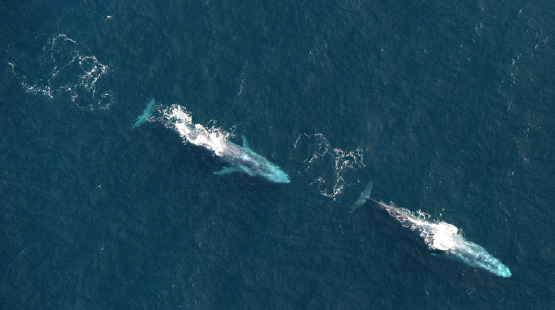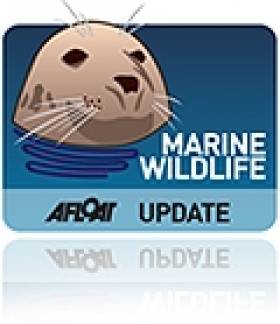Displaying items by tag: blue whale
A unique whale-shaped mosaic which is set for permanent public display aims to connect present-day Wexford with its storied maritime past, as RTÉ News reports.
With the help of artist Helen McLean, Wexford Arts Centre has been creating the patterned artwork from shards of Staffordshire pottery — known as ‘chanies’ — collected from the shore at Rosslare over many decades by local woman Ann Borg.
Many of these shards are believed to originate from the wreck of a US-bound ship that went down in Moran’s Bay in the 1850s.
They have now been used to create an impression of the blue whale that famously beached in Wexford in the 1890s — the skeleton of which now hangs inside the entrance of London’s Natural History Museum.
RTÉ News has much more on the story HERE.
Wexford Blue Whale Held Together With Old Newspapers
#BlueWhale - The skeleton of a blue whale beached in Ireland that's to be the centrepiece of London's Natural History Museum has been held together by old newspapers for more than 80 years, it has emerged.
Afloat.ie previously noted the Irish origins of the giant marine mammal remains that were recovered from the Wexford coast 125 years ago – and is next year set to replace Dippy the diplodocus in the London museum's atrium.
But as Kent Online reports, it was only recently discovered that parts of the massive skeleton were being held together with copies of the Kent Messenger newspaper from the 1930s.
Staff responsible for the careful reconstruction of the blue whale specimen found dated newsprint within the plaster-like material that had been used as 'stuffing' to pack out and hold together its bones.
According to a museum spokesperson, it indicates strong connections between the English county and the workers in London who prepared the whale for display.
Kent Online has more on the story HERE.
Voyages out as far as the edge of the Continental Shelf on the Atlantic Ocean has produced rare sightings for the Irish Whale and Dolphin Group and this August there is a chance to see the join the crew and see the whales again writes Patrick Lyne
Back in 2012 when the Celtic Mist became available to the Irish Whale and Dolphin Group we were looking at ways the boat could be used to support the work the Group does and demonstrate to people in Ireland the wealth of life that exists in Irish waters. So for three years from 2012 to 2014 we took the Celtic Mist to the shelf edge in early September. Indeed we were blessed when first arriving on the shelf edge only to be greeted by two blue whales. It took several minutes in close proximity (200m) to the whales before we believed our eyes. We had expected large whales but not those to be waiting for us. They stayed around and passed either side of the boat moving from port to starboard for what seemed like an age, before moving further away. We could manage a top speed of maybe 8 knots while blue whales could travel at up to 25 knots approximately and there was no way we could keep pace with these animals if they decided to leave us behind.
Shortly afterwards the Irish Air Corps Casa (C253) appeared and called on the radio and managed to get some excellent shots of both the Celtic Mist and the blue whales.
 Two blue whales in the Porcupine Seabight 60 miles off the Irish coast (Photo coutesy of Irish Air Corps)
Two blue whales in the Porcupine Seabight 60 miles off the Irish coast (Photo coutesy of Irish Air Corps)
In 2013 had some remarkable sightings of beaked whales again in the Porcupine Seabight and while unable to confirm that the animals that passed close to the vessel in 2013, were True’s beaked whales, it seems highly probable that they were. Beaked whales are particularly difficult to study being adverse to noise and spending large periods of time underwater. The Cuvier’s beaked whale holds the record for the longest recorded dive of any cetacean of 2 hours 17 minutes while attaining a depth of 2,992m. These animals are rarely seen close to shore and when they are, they often end up stranding and dying. The deep ocean off the shelf edge is their natural habitat.
Each year has produced it’s own spectcular moments and the humpback whales off Dingle have become more and more reliable and are a feature of our trips every year. Last year we were treated to one beautiful day on the shelf edge with calm weather. It is this calm weather that always produces the best results. While whales numbers wer not spectacular they were considerable and most if not all animals were engaged in feeding. We simply allowed the boat to drift while fin whales fed in close proimity to the boat and we could see the huge jaws opening to envelope the krill underwater.
Last year we changed vessels to Jessy of Adrigole a 37 ft–yacht, the Celtic Mist being unavailable and this year we have decided to continue using Jessy but for a longer trip. We propose starting in Castletownbere and sailing to Camaret in Brittany along the shelf edge. The shelf edge between here and Brittany is some of the most dramatic in the world with drop offs from 200m down to nearly 4000m. The EEZ of the UK is slowly squeezed such that French and Irish waters will eventually meet as boundaries extend.
It is more important than ever to record the variety and abundance of Ireland’s offshore environment. While oil exploration will suffer from the current over supply, exploration rights has been granted to both Russia and France by the International Seabed Authority (ISA – not the Irish Sailing Association but a UN body based in Jamaica) in the mid-Atlantic Ridge in the North Atlantic. The marine environment is constantly under greater and greater pressure. Protection for cetaceans is critical to mainting the entire marine habitat. Reduction in large whale numbers in the Southern Ocean due to whaling did not result in an increase in their favourite prey, krill, but rather reduced krill abundance. Whale faeces enriches the ocean with iron, producing plankton blooms which start the food chain and absorb excess carbon from the atmosphere. The South West in particualr sees large numbers of tuna arrive in August and September, follwoed by French and Spanish and Irish fishing vessel as well as whales. It is important for the whales that they are able to build blubber reserves at this time, especially for the females as without sufficient reserves to sustain them during pregnancy of 11 or 12 months, the whale will abort. Recovery rates are slow with these large whales and even with protection it will be manay many decades before fin and blue whale numbers reach pre-whaling levels.

Fin whale feeding Porcupine Seabight (Photo – Patrick Lyne IWDG)
In August we will embark again to try and find calm weather on the shelf edge and hope to add significantly to the picture of cetaceans in Irish waters in a time when they are at their most abundant. It is a unique opportunity for people to become involved with our marine mega fauna in a way not available elsewhere and to add to knowledge of the area. The charge to crew of €1310 allows the work to take place and is an enriching experience and an education. If interested contact Patrick Lyne by email ([email protected]).
London Natural History Museum's New Blue Whale Display Has Irish Origins
#MarineWildlife - News emerged this week that Dippy, the famous diplodocus cast at the entrance of London's Natural History Museum, is to be replaced with the skeleton of a blue whale.
But amid all the hubbub that this move has sparked, perhaps little known is the replacement creature's Irish origin.
According to Geographical, the magazine of the Royal Geographic Society, the museum's blue whale skeleton is from a female whale that was beached off Wexford more than 100 years ago.
The giant marine mammal was reportedly already injured when it washed up at Wexford Harbour in 1891, says whaling expert Phillip Hoare, who notes that the museum paid £250 (some £27,000 in today's money) for the carcass – which produced an incredible 630 gallons of valuable whale oil.
That rendering was done at the museum itself, which had a 'whale pit' reserved for such purposes till the 1940s, when complaints from the neighbours about the smell put paid to that practice.
What's more, the Wexford whale that will have pride of place in the museum's atrium is just one of countless other specimens acquired over the decades, many of which are stores in a warehouse in south London.
Geographical has more on the story HERE.
Blue Whales Spotted Off Kerry Coast in Ireland's Third Ever Sighting
#MARINE WILDLIFE - Members of the Irish Whale and Dolphin Group (IWDG) encountered the world's largest animals off the southwest coast of Ireland last Thursday.
Two blue whales were witnessed by the team on board the Celtic Mist near the edge of the continental shelf on the Porcupine Blight, west of Dursey Island in Co Kerry.
The marine giants - last recorded in Irish waters back in 2008 - reportedly surfaced within 500 metres of the boat.
Mission co-ordinator Patrick Lyne told The Irish Times that there may even have been three whales in the pod, as three blows of seawater were witnessed in a short space of time.
He also noted that the sighting was very significant as there are estimated to be fewer than 4,000 blue whales in the entire northern hemisphere - their numbers reduced drastically by whaling over the past hundred years.
At an average of 30 metres in lengh and an incredible 180 metric tins in weight, the blue whale is the largest animal to have ever lived on earth.
The Celtic Mist was on its maiden voyage as a research vessel for the IWDG, following its gifting to the group for marine wildlife conservation work by the Haughey family last year, and subsequent major refitting works.
The vessel set sail on Monday 3 Septmeber on a marine mammal observation and passive acoustic monitoring week, carrying a towed hydrophone array for acoustic detections below the surface.
During the weeklong mission the team on board enountered 11 different cetacean species including harbour porpoises, common dolphins, minke whales and a humpback whale.
Link to Blue Whales Spotted During an Air Corps Maritime Patrol
Celtic Mist Will Track Elusive Blue Whale
The infamous Celtic Mist is set to be used to track one of the most elusive marine animals in Irish waters.
The Irish Examiner reports that one of the first duties of the yacht under its new ownership by the Irish Whale and Dolphin Group (IWDG) will be to track down the blue whale, the last of which was spotted off the Irish coast in 2009.
"We’ve made two sightings of the blue whale on the shelf edge but with the Celtic Mist we will be able to go out there for a few weeks and sit there and wait for them," said the IWDG's Dr Simon Berrow.
"Hopefully we will find some more when we bring the Celtic Mist out there. They are very rare."
The blue whale is regarded as the largest animal to have ever lived on earth. They also have an average lifespan of well over 100 years.
As previously reported by Afloat.ie, Celtic Mist was gifted by the Haughey family to the IWDG earlier this year to assist in its marine conservation work.
The yacht competed in a leg of the 2011 Tall Ships Race from Waterford to Scotland before moving to its new home in Co Clare, where it will be refitted for its new life as a research vessel.



























































